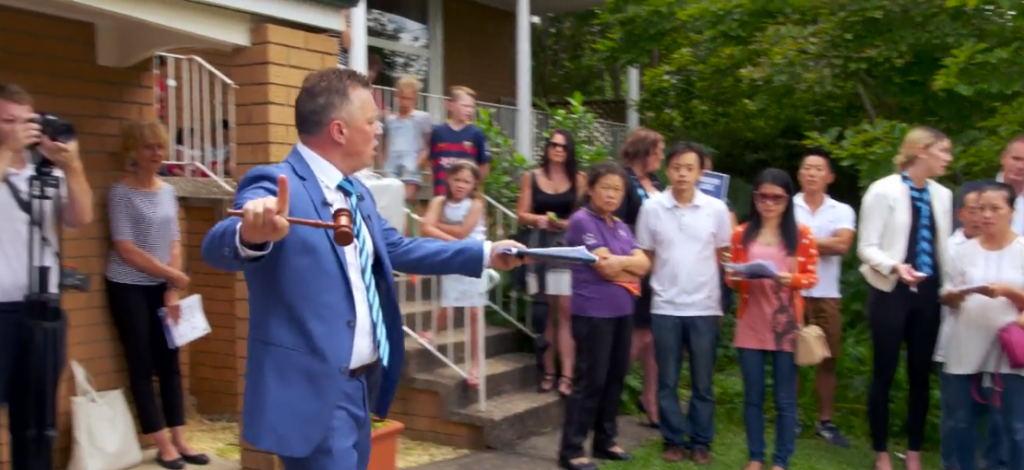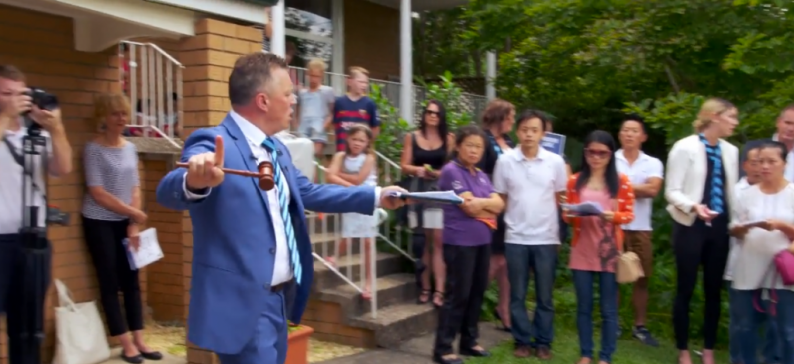Perverse Incentives
We haven’t written about Australia’s residential real estate bubble for some time (readers may want to check out last year’s post “Australia’s Bubble Trouble”, which contains numerous relevant charts and data).

Property auction in Sidney
Our friend Jonathan Tepper of Variant Perception has recently visited Australia for a fact-finding tour (more on this further below), so we felt we might as well take the opportunity to write an update on the topic.

House prices in Sidney vs. the administered interest rate of the Reserve Bank of Australia. As you will see below, interest rates aren’t the only driver of the bubble – click to enlarge.
Our reader D.S., who has moved to Australia five years ago, has provided us with a number of very interesting observations on the Australian housing market late last year, which we are sharing below. As D.S. notes, there are a number of interesting wrinkles specific to Australia’s real estate market, which outsiders are generally not likely to be aware of. We have highlighted a few passages in his report below which we think are especially important:
“The housing bubble in Australia has been talked about so extensively and has lasted so long without any harm coming to it that people here have pretty much dismissed the very possibility of a crash – including, it has to be said, the chances of a recession. The reason I was motivated to write this note is because there are some (I believe) unique dynamics at play in this housing market, which aren’t necessarily apparent to the outsider – at least, I was never aware of them until I moved here.
Australia has one of the highest levels of home ownership in the developed world and, in common with other Anglophone countries, the home is commonly viewed as people’s ‘primary asset’ i.e. the financial windfall they will one day be leaving to their children. When the property market is hot — as it has been in the past couple of years — people love nothing more than to talk about property values and how well they’re doing. Property developers, meanwhile, are presently building furiously in order to sell into current demand. Perhaps this is all that is propping up GDP growth right now (making the latest weak print all the more relevant).
To begin: Australia has a fairly unique approach to ensuring its citizens are provided for in retirement i.e. they have a system of mandatory saving for all workers – superannuation – which is supposed to provide the majority of contributors a healthy lump sum on which to retire. Funds are essentially deducted from each salary check and the proceeds typically invested in stocks by their friendly investment firm (think mutual fund, long-only, index-hugging types). There are a number of major issues with this system, not least declining forecast returns (in recent years), which means that future employee contributions will need to rise sharply, but that’s a discussion for another time.
Leaving aside the ideological objections to ‘forced saving’, this arrangement appears quite sensible as the State certainly doesn’t want to end up providing for those who would rather ignore retirement planning altogether. But the Superannuation system also means that Australians have one of the highest per capita equity exposures in the world (not that investment in equities is mandatory either but, culturally, equities is pretty much the only show in this town).
Again, this may not appear to be a bad thing, but here’s the problem: Australia’s banking oligopoly makes up fully 30+% of the entire main index (where the majority of Superannuation is invested) and the actual exposure to banks may be greater given that the ‘Big 4’ banking stocks have the most attractive dividend yields in the index. A quick glance at the ‘Big 4’ balance sheets reveals that the biggest single exposure they have is to is residential real estate (60+% in each case). This leaves the average Australian home-owner much more exposed to the real-estate market than most would appreciate.
But it doesn’t end there. Australia has a perverse tax subsidy called ‘negative gearing’, the origins of which I am not certain, but it effectively allows owners of investment properties to offset any losses they incur on that investment against personal income for tax purposes. This has made owning investment property de rigeur among many middle class Australians and, again,Australians have one of the highest levels of investment property ownership in the developed world (no doubt aided by this incentive). The incentive, of course, means that such property is very often acquired at what would be deemed, absent the subsidy, economically unattractive levels.
The ‘negative gearing’ subsidy is widely held by the public to be too politically sensitive to be considered for ‘review’, but talk of winding it back has started to crop up in the media for the first time in many years. In common with just about every other DM country the fiscal situation here is deteriorating and the government is under increasing pressure to address it. Negative gearing, depending on the source, costs the treasury some $8bn to $16bn per annum and the left-leaning opposition party, the ALP, is contemplating whether to make negative gearing one of the central policy planks at the next election (investment properties are largely deemed the domain of the better-off LNP supporter, after all).
And it gets worse: the government, in recent years, made Self Managed Superannuation Funds (SMSFs) more broadly accessible to its citizens so that they weren’t held hostage by the inherent limitations of mutual fund managers. In a subsequent development, SMSFs were then allowed (indeed, encouraged) to include residential property, which has led to a stampede by retirement savers into the investment property market — aided by a tsunami of positive media coverage. This change is undoubtedly partially responsible for the latest big leg up in the already substantial bubble. Apartment blocks have been going up like mushrooms all over metropolitan Australia to meet demand from investment buyers, Superannuation funds and the ubiquitous Chinese (collectively a whopping 40% of all buyers). Meanwhile, first-time buyers are reportedly, at their lowest levels (as a proportion of buyers) in history.
Glenn Stevens (the Reserve Bank of Australia governor) has been fairly open in admitting that this next leg up in the property boom is designed to build a bridge to a resource-sector recovery (whenever that may be) but that strikes me as a hell of a risk given the state of the global economy and its current trajectory. The property bubble is everything to this economy and the country’s citizens, whether they know it or not, are ‘all in’.














Leave A Comment